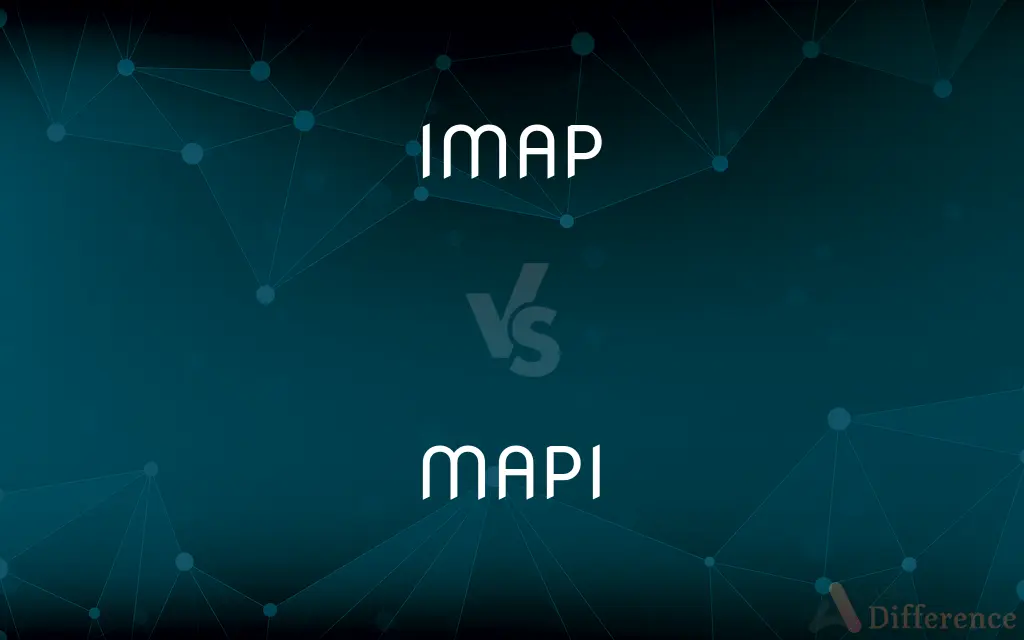IMAP vs. MAPI — What's the Difference?
By Tayyaba Rehman & Fiza Rafique — Published on February 7, 2024
IMAP (Internet Message Access Protocol) is for accessing emails from a server. MAPI (Messaging Application Programming Interface) is a Microsoft API for email and messaging services.

Difference Between IMAP and MAPI
Table of Contents
ADVERTISEMENT
Key Differences
IMAP is a standard email protocol that allows users to access their emails from a remote server, making it ideal for managing emails across multiple devices. It provides flexibility in how emails are stored and synchronized, allowing users to view their email messages without downloading them to their local device. IMAP supports both online and offline access to emails, maintaining the email on the server while allowing a copy to be stored locally if needed.
MAPI, on the other hand, is more than just an email protocol; it's a messaging architecture and a set of APIs developed by Microsoft. MAPI enables client applications to become messaging-enabled, -aware, or -based by calling MAPI subsystem routines that interface with certain messaging systems. MAPI provides a rich set of functions for managing emails, appointments, contacts, and tasks, and it is deeply integrated with Microsoft Outlook and Exchange Server, offering features like shared calendars and public folders.
While IMAP focuses on the retrieval and management of email messages from a mail server, MAPI offers a broader range of functionalities, including complex operations like calendar management, meeting requests, and more. IMAP is widely used and supported by various email clients and services, making it a universal solution for email access. MAPI, being proprietary to Microsoft, is specifically designed to work within the Microsoft ecosystem, providing enhanced features and integration for users of Microsoft's email and messaging services.
IMAP allows users to manage their email in a flexible manner, providing options to organize, delete, or move messages between folders on the server. This means changes made in one email client are reflected in all others synchronized with the same IMAP account, providing a consistent view of the email messages. MAPI's functionality extends beyond simple email management, enabling complex interactions with messages, such as setting follow-up flags, categories, and integrating with other Microsoft Office applications.
In summary, IMAP is a protocol suited for accessing and managing email across multiple devices, providing a standardized way to interact with email messages stored on a server. MAPI, however, offers a comprehensive messaging framework that supports advanced features beyond email, tailored for the Microsoft environment, including integration with various Microsoft services and applications.
ADVERTISEMENT
Comparison Chart
Primary Use
Accessing and managing email
Microsoft's messaging architecture
Functionality
Email synchronization
Email, calendar, contacts, tasks management
Compatibility
Universal with various email services
Primarily for Microsoft Outlook and Exchange
Features
Basic email operations
Advanced features like shared calendars
Protocol/API
Email protocol
Messaging API
Compare with Definitions
IMAP
Flexible email management.
IMAP allows me to organize my emails into folders directly on the server.
MAPI
Microsoft's messaging API.
MAPI integrates my email and calendar in Outlook.
IMAP
Synchronizes emails across devices.
With IMAP, deleting an email on my phone also removes it from my laptop.
MAPI
Enables rich client-server communication.
MAPI provides a seamless connection between Outlook and Exchange.
IMAP
Email access protocol.
I use IMAP to check my emails from different devices.
MAPI
Supports complex operations.
MAPI allows for detailed email categorization and follow-up reminders.
IMAP
Stores emails on the server.
IMAP keeps all my messages on the server, saving local storage space.
MAPI
Tailored for the Microsoft ecosystem.
MAPI's functionality is optimized for Microsoft's suite of productivity tools.
IMAP
Supports offline access.
I can read my downloaded IMAP emails even without an internet connection.
MAPI
Offers advanced messaging features.
Using MAPI, I can schedule meetings directly from my email client.
Common Curiosities
Does IMAP store emails locally?
IMAP can store emails locally for offline access, but it primarily stores emails on the server.
What are the IMAP server settings for popular email providers?
Server settings vary by provider; you should contact your email provider for specific IMAP configuration details.
What does IMAP stand for?
Internet Message Access Protocol.
Is MAPI only for Microsoft products?
Primarily, yes, especially Outlook and Exchange Server.
Does IMAP work with mobile devices?
Yes, IMAP is compatible with mobile devices and can be used on smartphones and tablets.
What is MAPI?
Messaging Application Programming Interface, a Microsoft API.
Can I use IMAP with any email service?
Yes, most email services support IMAP.
Is MAPI a secure protocol?
MAPI can be secured using encryption and authentication mechanisms to protect email data in transit and at rest.
Is MAPI compatible with mobile devices?
MAPI is more commonly used on desktop platforms, and mobile integration may vary.
Can MAPI be used with non-Microsoft email clients?
MAPI is designed for Microsoft products, so its use is limited outside the Microsoft ecosystem.
Can I use IMAP to access my email offline?
IMAP typically requires an internet connection to access and synchronize emails.
Can I use MAPI for sending and receiving emails programmatically?
Yes, MAPI provides APIs for developers to send, receive, and manage emails within their applications.
Is MAPI suitable for email synchronization across devices?
MAPI is primarily used for integrating email features within applications and is not designed for email synchronization across multiple devices like IMAP.
Is IMAP suitable for large email accounts?
IMAP can handle large email accounts, but the performance may depend on your email server and internet connection.
Is MAPI still widely used today?
MAPI is less common today due to the shift towards web-based email and other APIs, but it is still used in some desktop applications.
Share Your Discovery

Previous Comparison
High Heel vs. Stiletto
Next Comparison
Soup vs. ShorbaAuthor Spotlight
Written by
Tayyaba RehmanTayyaba Rehman is a distinguished writer, currently serving as a primary contributor to askdifference.com. As a researcher in semantics and etymology, Tayyaba's passion for the complexity of languages and their distinctions has found a perfect home on the platform. Tayyaba delves into the intricacies of language, distinguishing between commonly confused words and phrases, thereby providing clarity for readers worldwide.
Co-written by
Fiza RafiqueFiza Rafique is a skilled content writer at AskDifference.com, where she meticulously refines and enhances written pieces. Drawing from her vast editorial expertise, Fiza ensures clarity, accuracy, and precision in every article. Passionate about language, she continually seeks to elevate the quality of content for readers worldwide.














































